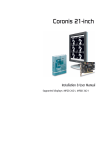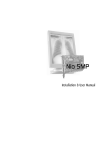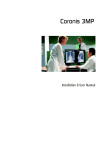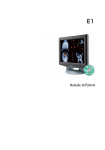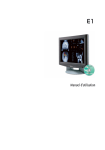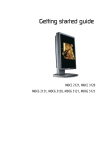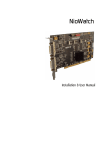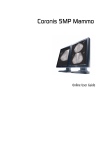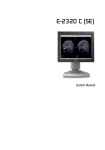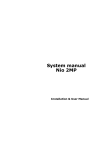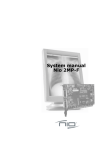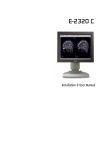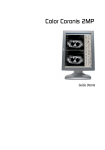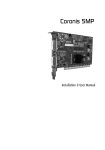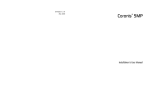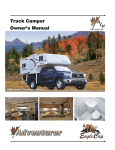Download Barco Nio systems User manual
Transcript
Nio systems Installation & User Manual Supported displays: E-2620, E-2620 S, E-2621, E-3620, E-3621, E-5620, MDNG-5121 (This page intentionally left blank.) 2 Nio systems Copyright notice This document is copyrighted. All rights are reserved. Nor this document, nor any part of it, may be reproduced or copied in any form or by any means - graphical, electronic, or mechanical including photocopying, taping or information storage and retrieval systems without written permission of Barco © 2007 Barco N.V. All rights reserved. Nio systems 3 (This page intentionally left blank.) 4 Nio systems Table of Contents Table of Contents Preface........................................................................................ 7 Safety Instructions............................................................................. 11 Explanation of symbols ..................................................................... 14 Overview................................................................................... 17 Introduction ....................................................................................... 19 BarcoMed NIO display controller overview ...................................... 21 Package contents .............................................................................. 23 Parts, controls and connectors.......................................................... 24 Installation................................................................................ 27 Installation precautions..................................................................... 29 Display controller installation ........................................................... 30 BarcoMed PCI Express® Controllers............................................ 33 Display installation ............................................................................ 35 After unpacking the display....................................................... 35 Power connection....................................................................... 38 Video connection........................................................................ 39 USB connection........................................................................... 40 Cable routing .............................................................................. 40 Attaching the display to an arm stand............................................. 42 Software installation ......................................................................... 44 Installing the BARCOMED display controller drivers and software.. 44 NioWatch............................................................................................ 49 Settings for optimal display performance throughout the product lifetime ................................................................................ 50 Avoiding image retention.......................................................... 50 Operation .................................................................................. 53 BarcoMed control panel operation ................................................... 55 Nio systems 5 Table of Contents Accessing the Barco tab ............................................................. 55 Advanced Properties .................................................................. 57 Device details ............................................................................. 60 NioWatch operation........................................................................... 61 Display settings .......................................................................... 62 Test patterns ............................................................................... 69 Application settings.................................................................... 70 Update NioWatch........................................................................ 72 Display operation .............................................................................. 73 Display operation ....................................................................... 73 Cleaning .................................................................................... 79 Precautions ........................................................................................ 81 Front filter (protective screen).......................................................... 82 Front glass.......................................................................................... 83 LCD panel ........................................................................................... 84 Cabinet ............................................................................................... 85 Troubleshooting........................................................................ 87 General tips........................................................................................ 89 Technical Information............................................................... 95 Technical specifications ..................................................................... 97 Connector pin assignments............................................................. 110 Glossary............................................................................................ 111 Warranty Statement ............................................................... 113 6 Nio systems Preface Nio systems 7 Preface (This page intentionally left blank.) 8 Nio systems Preface Notice Although every attempt has been made to achieve technical accuracy in this document, we assume no responsibility for errors that may be found. Our goal is to provide you with the most accurate and usable documentation possible; if you discover errors, please let us know. BarcoView software products are the property of BarcoView. They are distributed under copyright by Barco N.V. or BarcoView, LLC., for use only under the specific terms of a software license agreement between Barco N.V. or BarcoView LLC. and the licensee. No other use, duplication, or disclosure of a BarcoView software product, in any form, is authorized. The specifications of BarcoView products are subject to change without notice. Trademarks All trademarks and registered trademarks are property of their respective owners. FCC notice (display) This equipment has been tested and found to comply with the limits of a Class A digital device, pursuant to Part 15 of the FCC rules. These limits are designed to provide reasonable protection against harmful interference when the equipment is operated in a commercial environment. This equipment generates, uses and can radiate radio frequency energy and, if not installed and used in accordance with the instruction manual, may cause harmful interference to radio communications. Operation of this equipment in a residential area is likely to cause harmful interference in which case the user will be required to correct the interference at his own expense. Canadian notice This Class A digital apparatus complies with Canadian ICES-003. Cet appareil numérique de la Classe A est conforme à la norme NMB003 du Canada. Nio systems 9 Preface Disposal Information The lamps inside the display contain mercury. Do not throw the display in the trash. Dispose of it as required by local ordinances or regulations. 10 Nio systems Safety Instructions Safety Instructions General Recommendations Read the safety and operating instructions before operating the display. Retain safety and operating instructions for future reference. Adhere to all warnings on the display and in the operating instructions manual. Follow all instructions for operation and use. Electrical shock Type of protection (electrical): Class I equipment Degree of safety (flammable anesthetic mixture): Equipment not suitable for use in the presence of a flammable anesthetic mixture with air or with oxygen or nitrous oxide. Power connection • Power requirements: The display must be powered using the 12 VDC power supply that is supplied with the display. • The 12 VDC power supply must be powered by the AC mains voltage. • Power cords: Power cord with CEE 7 plug: The colors of the mains lead are colored in accordance with the following Nio systems 11 Safety Instructions code: Green-and-yellow: Earth (safety earth), Blue: Neutral, Brown: Line Power cord with ANSI 73.11 plug: The wires of the power cord are colored in accordance with the following code: Green/yellow: ground, White: neutral, Black: line (live) • Do not overload wall outlets and extension cords as this may result in fire or electric shock. • Mains lead protection (U.S.: Power cord): Power cords should be routed so that they are not likely to be walked upon or pinched by items placed upon or against them, paying particular attention to cords at plugs and receptacles. Water and moisture Never expose the display to rain or moisture. Never use the display near water - e.g. near a bathtub, washbasin, swimming pool, kitchen sink, laundry tub or in a wet basement. Ventilation Do not cover or block the ventilation openings in the cover of the set. When installing the display in a cupboard or another closed location, heed the necessary space between the set and the sides of the cupboard. Installation Place the display on a flat, solid and stable surface that can bear the weight of at least 3 displays. If you use an unstable cart or stand, the display may fall, causing serious injury to a child or adult, and serious damage to the equipment. More warnings in the Installation chapter. 12 Nio systems Safety Instructions Operating precautions: How to avoid image retention Continuous operation of the display with the same image may result in some image sticking on the LCD panel. Over 10 hours operation with the same image content is not recommended. To decrease the risk of image sticking (image retention): • Switch on DPMS on display and PC • Activate a good screen saver This apparatus conforms to: CE (LVD 73/23/EEC), IEC 60950-1, UL 60950-1, CAN/CSA C22.2 No. 60950-1 (c-UL), EN 60950-1 DEMKO, CCC GB4943-1995 National Scandinavian Deviations for Cl. 1.7.2 : Finland: "Laite on liitettävä suojamaadoituskoskettimilla varustettuun pistorasiaan" Norway: "Apparatet må tilkoples jordet stikkontakt" Sweden: "Apparaten skall anslutas till jordat uttag" Nio systems 13 Explanation of symbols Explanation of symbols Symbols on the display and / or power supply On the display or power supply, you may find the following symbols: Indicates the display is approved according to the CE regulations Indicates the display is approved according to the UL regulations or Indicates the display is approved according to the c-UL regulations or Indicates the display is approved according to the DEMKO regulations Indicates the display is approved according to the CCC regulations Indicates the USB connectors on the display Indicates this apparatus must not be thrown in the trash but must be recycled, according to the European WEEE (Waste Electrical and Electronic Equipment) directive 14 Nio systems Explanation of symbols Symbols used throughout the manual: Nio systems Warning Caution Important notice or remark Note Hint, tip Additional information 15 Explanation of symbols (This page intentionally left blank.) 16 Nio systems Overview Nio systems 17 Overview (This page intentionally left blank.) 18 Nio systems Introduction Introduction Thank you for choosing Barco. Single display or complete system? This manual describes installation and usage of a complete NIO system. A NIO system is a bundling of one or more displays and one or more display controllers. However, if you have purchased the display only instead of a NIO system, please refer to the chapters in this manual covering the display, and disregard the information about the display controller or NIOWATCH software. The displays The E-2620 (S) is a 19.8-inch grayscale LCD display with a native resolution of 1600 x 1200. The E-2621 is a 21.3-inch grayscale LCD display with a native resolution of 1600 x 1200. The E-3620 is a 20.8-inch grayscale LCD display with a native resolution of 2048 x 1536. The E-3621 is a 21.3-inch grayscale LCD display with a native resolution of 2048 x 1536. The E-5620 is a 20.1-inch grayscale LCD display with a native resolution of 2560 x 2048. The MDNG-5621 is a 21.3-inch grayscale LCD display with a native resolution of 2560 x 2048. It is available in a clearbase and bluebase version. Their high-brightness, combined with image crispness and excellent viewing angle, makes them ideal for a multitude of medical applications and environments. Nio systems 19 Introduction Long-term stabilization The displays contain a Backlight Output Stabilization system (BLOS©), which continuously stabilizes the luminance output of the LCD’s backlight. This improves the overall optical efficiency and provides longterm image confidence. NioWatch In NIO systems, the display comes standard with NIOWATCH, a userfriendly software tool that optimizes the LCD panel for DICOM-compliant viewing. Power saving The displays are equipped with a power saving system. When left idle for a certain time, the computer connected to the display, will power down the display. The power saving system can be switched on or off using the on-screen menus. Tilt & swivel base The versatile tilt & swivel foot allows to use the display for viewing portrait or landscape image resolutions. The user can easily change the panel height and viewing angle, allowing to use the display in the optimal viewing conditions. 20 Nio systems BarcoMed NIO display controller overview BarcoMed NIO display controller overview The BarcoMed NIO Display Controller delivers a quality image with 1024 simultaneous shades of gray for medical viewing applications. Minimum system requirements • Pentium II 266 MHz with 128 MB RAM (Pentium II 800MHz with 256 MB RAM for cineloops) Important: Other hardware and software installed in the system may require more system memory for best performance. • PCI 3.0 compliant slot (PCI version) or PCIe 1.1 compliant slot (PCIe version) • Windows® XP Professional Windows® 2000 Professional Windows® Server 2003 Windows® XP Professional x64 Edition Windows® Server 2003 x64 Edition Features of the BarcoMed NIO display controller • Portrait or landscape mode • Dual head configuration • 10-bit in/10-bit out LUT • 1024 Simultaneous shades of gray • Hardware cursor • Displays VGA boot messages on Nio displays. • 64-bit/66Mhz Single slot PCI card (PCI version)1 • 64MB Video memory (PCI version) • Single slot PCIe x8 card (PCIe version)2 • 128MB Video memory (PCIe version) 1. May be installed in a 32-bit/33Mhz PCI slot but with reduced performance. 2. May be installed in a PCIe x16 slot, however not all PC Bios’s support x8 cards in the x16 slot. Check with your PC manufacturer. Nio systems 21 BarcoMed NIO display controller overview Supported resolutions for each head of the BarcoMed NIO display controller • 1200 x 1600 @ 60 HZ (primary) • 1600 x 1200 @ 60 Hz • 1536 x 2048 @ 60 HZ (primary) • 2048 x 1536 @ 60 Hz • 2048 x 2560 @ 60 HZ (primary) • 2560 x 2048 @ 60 Hz The following resolutions are also available on head 1 when the OS is booted in VGA mode. • 640x480 @ Default Refresh Rate, 16 colors (4-bit color), grayscale • 800x600 @ Default Refresh Rate, 256 colors (8-bit color), grayscale System Configuration Guidelines Because of the low power consumption and low heat generation of the BarcoMed NIO display controller, multiple controllers may be installed in adjacent PCI/PCIe slots or adjacent to other PCI/PCIe boards. Additionally there should be no need to modify either the PC’s power supply and/or cooling system. 22 Nio systems Package contents Package contents Nio System package Each NIO system contains one or more display boxes (see below) and a system accessory box containing the following items: • Display controller(s) • CD-ROM with driver, NioWatch software and documentation Display box Each display box includes one display and a display accessory box containing the following items: • Plastic cover of the tilt & swivel foot • Power supply • Digital video (DVI) cable (25-pins) • Two velcro strips to bind the cables • European power cord • American power cord • Chinese power cord • This manual • Quick install card If some of the items are missing, please contact the reseller from whom you have purchased the unit. Nio systems 23 Parts, controls and connectors Parts, controls and connectors Front c d BAR CO e Figure 1: Front side 1. Power LED The LED is off when the display is disconnected from the power. The LED is also off when the LED function is disabled in the onscreen display (OSD). The LED is green when the display is on (when enabled in the onscreen menus). The LED is orange when the display is in Stand-by power-saving mode. 2. USB downstream port. See also item “7.” on page 25 3. Control wheel The control wheel can be pressed like a push button and rotated like a knob. It allows to put the display in stand-by, navigate through the onscreen display (OSD) menus and change values in the OSD. 24 Nio systems Parts, controls and connectors Rear c d f g h i j k e Figure 2: Rear side 1. Connector compartment cover To get access to the connectors, remove the cover by pulling down the 2 clips at the top of the cover. 2. Tilt & swivel foot cover This cover is packed in a separate box when the display is shipped to the customer. 3. Tilt & swivel foot 4. Slot for security cable (e.g., Kensington lock) 5. DVI (digital) video input 6. USB upstream port Connect this connector to the PC USB bus if you wish to connect USB devices to the display’s USB downstream port. 7. USB downstream port When the display is connected to the PC USB bus, you can connect USB devices, such as keyboard, mouse, digital camera, to this connector. 8. DC power input Nio systems 25 Parts, controls and connectors Connect the external power supply, delivered with the display, to this connector. 9. Tilt & swivel foot clip The display is shipped with this clip in the foot to protect the tilt & swivel mechanism during transport. After unpacking, you should remove this clip. Do not throw the clip away! Should the display have to be packed and shipped later, the clip must be applied to the foot again. 26 Nio systems Installation Nio systems 27 Installation (This page intentionally left blank.) 28 Nio systems Installation precautions Installation precautions Precautions • Keep your original packaging. It is designed for this display and is the ideal protection during transport. • Avoid reflections in the flat panel to reduce eye strain. • Place the display on a strong and stable table or desk. • Keep the display away from heat sources and provide enough ventilation around the display. • Do not use the display in direct sunlight. • Do not scratch or apply pressure to the LCD panel. This may damage the panel permanently. Nio systems 29 Display controller installation Display controller installation Caution: Wear a grounded, protective ESD strap during installation or handling of the display controller. Electrostatic charges can damage the display controller. Prior to installing your BarcoMed NIO display controller(s) in your PC please take a few minutes to familiarize yourself with both the display controller(s) and the PCI slots in your computer. Figure 3: The BarcoMed NIO display controller Using the VGA capabilities of the BarcoMed NIO display controller Prior to installing the BarcoMed NIO controller, decide if you are going to use its on-board VGA capabilities. If you are, check the setting of the Jumper at J-1 on the display controller (see figure 4). By default, VGA should be enabled, on the top two pins. 30 Nio systems Display controller installation Figure 4 If you decide to use a separate VGA monitor as your boot monitor, you must disable the BarcoMed NIO’s on-board VGA capabilities by moving the jumper to the bottom two pins. Caution: To use multiple BarcoMed NIO controllers in a single host with VGA enabled, you should enable VGA on only ONE of the BarcoMed NIO display controllers and disable VGA on ALL the other BarcoMed NIO display controllers. Examples of PCI slots Although the BarcoMed NIO is a 64-bit board, it may be installed in either a 64-bit or 32-bit PCI slot. However, installing it in a 32-bit PCI slot will result in a decrease in performance. Figure 5 illustrates the types of slots so that you can correctly identify which one to use for the BarcoMed NIO. Nio systems 31 Display controller installation Figure 5: PCI and RAID Controller Slots Installing the BarcoMed NIO display controller Install the BarcoMed NIO controller in your computer following these steps: 1. Turn off the power to your computer and disconnect the power cord, however make sure that the computer chassis is still grounded. 2. Remove the chassis cover according to the manufacturer’s instructions. Be sure to observe safety warnings. 3. If you have decided to use the on-board VGA capabilities of the BarcoMed NIO (see Using the VGA capabilities of the BarcoMed NIO display controller on page 30), you must now remove any VGA display controller(s) that are currently installed in the computer or disable any VGA controllers that are integrated into your PC’s motherboard. 4. Install the BarcoMed NIO display controller into a free PCI slot, either 64-bit or 32-bit (see figure 5, for examples of slots). Be sure that the display controller is seated firmly in the slot. 5. Secure the card to the chassis with the PC’s I/O panel mounting screw, and replace the chassis cover. 6. Connect the primary display to the connector marked “VID 1” on the BarcoMed NIO display controller using the provided DVI cable 32 Nio systems Display controller installation (see figure 6). For a dual-headed BarcoMed NIO setup, connect the secondary display to the other connector on the display controller. 7. Reconnect the power cord, turn on the power, and boot the system as usual. Running multiple BarcoMed NIO Display Controllers in a single host The physical order of the displays may vary when you are running multiple BarcoMed NIO display controllers. This is due to the PC’s PCI bus control in the system BIOS, and not the BarcoMed display controller. It may become necessary, depending on how your PC’s BIOS configures the PCI bus, to switch your DVI display connections to achieve a linear desktop configuration. Figure 6 BarcoMed PCI Express® Controllers During the first quarter of 2006 Barco Medical Imaging Systems added PCI Express (PCIe) versions of its display controllers to its grayscale Medical Imaging Display Systems product line. The PCIe versions of Nio systems 33 Display controller installation these boards will have the same features as the currently shipping PCI version. All three PCIe boards will feature a x8 logical bus on a x8 physical connector. They have been designed to function in PCI Express x8 or x16 slots. Optimum performance will always be obtained by installing them in a PCIe x8 slot. Depending on your PC manufacturer’s implementation of the logic for the PCIe x16 slot optimum performance may also be obtained by installing the Barco PCIe boards in the PCIe x16 slot. Connecting your Barco displays to your BarcoMed PCIe board is identical to connecting them to a BarcoMed PCI board (please refer to your system manual for details). Figure 7: Examples of PCI Express Slots 34 Nio systems Display installation Display installation After unpacking the display Important: In the factory, the height-positioning system in the display foot is blocked with a red clip to prevent damage during transportation. Before installing the display, you must remove this clip. Clip Figure 8 To remove the clip: 1. Position the display with its rear side facing you. 2. Pull the red clip out of the fixation holes in the foot. 3. Keep the clip in case the display needs to be shipped later. Nio systems 35 Display installation Adjust the panel orientation You can change the orientation of the panel at any time, but it is more convenient to select landscape or portrait orientation before connecting the cables. BAR CO Figure 9: Portrait orientation BAR CO Figure 10: Landscape orientation To change the panel orientation: 1. Stand at the front side of the panel and take the panel at both sides. 2. Very important: Tilt the panel before changing the orientation. Should you change the panel orientation without tilting it first, you might irreversibly damage the tilt & swivel mechanism. 36 Nio systems Display installation Figure 11: Tilt the panel before rotating 3. To change from portrait to landscape, turn the panel counterclockwise. BAR CO Figure 12: To rotate the panel from portrait to landscape 4. To change from landscape to portrait, turn clockwise. Notice: If, after installing the display or the system, you change the panel orientation while an image is on the screen, the result depends on your application: Nio systems 37 Display installation • In a complete NIO system, the image orientation will adapt to the new panel orientation automatically after a second. • If you would use the display without the NIO display controller board, the image orientation will not change with the panel orientation. To change the orientation of the image, you will have to change the resolution in the Windows Display control panel (if possible). Power connection To connect the power: (2) Figure 13 (2) (3) Figure 14 1. To get access to the connectors, remove the connector compartment cover by pulling down the 2 clips at the top of the cover. 38 Nio systems Display installation 2. Connect the output of the 12V DC power supply to the DC input of the display. 3. Connect one end of the proper power cable to the AC input of the 12V DC power supply. 4. Connect the other end of the power cord to a grounded power outlet. Video connection Connecting DVI cables: One display: (1) Figure 15 1. Connect one end of the DVI cable to the DVI input of the display. 2. Connect the other end of the DVI cable to the DVI connector of the display controller board. If this board has 2 video heads (2 video outputs), connect to output Vid 1 (Head A). Connecting DVI cables: Two displays: 1. Connect the left display (when looking at the front side) to display controller output Vid 1 (Head A) as described above. 2. Connect the second display to output Vid 2 (Head B). Nio systems 39 Display installation USB connection The USB connection allows you to use the display as USB hub, to which you can connect USB devices, such as a keyboard, mouse or digital camera. To connect the USB cable: (1) (2) Figure 16 1. Connect a PC USB downstream connector to the display’s USB upstream connector by means of a USB cable. 2. Connect any USB device to one of the display’s USB downstream connectors. Cable routing Routing the signal cables • Bind the cables in the connector compartment together with the cable tie inside the connector compartment. • Put the connector compartment cover back on the display. Pay attention that the signal cables are positioned under the bulge in the cover. • Push the cables into the clips on the rear of the tilt & swivel foot. 40 Nio systems Display installation • Bind the cables together above and under the foot, by means of the 2 velcro strips attached to the inside of the foot cover (packed inside the accessory box). • At last, put the foot cover back in place. To put the foot cover in place: (2) Figure 17: 1. The foot cover is packaged separately in the accessory box. Unpack the foot cover. 2. Push the upper side of the cover onto the foot, so that the hooks inside the cover are positioned right under the bulges at the rear of the foot. 3. Slide the cover upward while moving the lower side of the cover towards the foot. 4. Press the cover to the foot so that it makes a clicking sound. Nio systems 41 Attaching the display to an arm stand Attaching the display to an arm stand The panel, standard attached to the tilt & swivel foot, is compatible with the VESA 100 mm standard. So it can be used with an arm stand according to the VESA 100 mm standard. Therefore, the tilt & swivel foot must be removed from the panel. Important: • Use an arm that is approved by VESA (according to the VESA 100 mm standard). • Use an arm that can support a weight of at least 13 kg (28.66 lbs). To attach the display to an arm stand: 1. Put the display face down on a clean and soft surface. Be careful not to damage the panel screen. 2. Remove the tilt & swivel foot cover. 3. Remove the small screw (A) fixing the small plastic cover on top of the foot. Next, remove the small cover itself. B A Figure 18: Display with tilt & swivel foot cover removed 4. Unscrew the 2 screws fixing the round plastic cover (B). 5. Lift up the round plastic cover. 42 Nio systems Attaching the display to an arm stand 6. Remove the four screws fixing the foot while supporting the foot. 7. Attach the arm stand firmly to the panel using 4 screws M4 x 8 mm. 4 screws M4 x 8mm Figure 19 Nio systems 43 Software installation Software installation Installing the BARCOMED display controller drivers and software Note: The installation dialog will display in English if your operating system’s language is not supported. This process applies to the following versions of Windows: • • • • • Windows 2000 Professional, Windows XP Professional, Windows Professional x64 Edition, Windows Server 2003, and Windows Server 2003 x64 Edition. You will need to install the BARCO MEDICAL IMAGING DISPLAY SYSTEM drivers and software in the following cases: • After you have installed the display controller(s) for your BARCO MEDICAL IMAGING DISPLAY SYSTEM in your system for the first time. • After you have reinstalled or upgraded your operating system. 1. Start your system. When the Found New Hardware Wizard comes up, click Cancel. When the System Settings Change window asks you to restart your computer, click No. Put the Nio 2MP display panel in landscape position before installing the software. Put the Nio 3MP/5MP display panel in portrait position before installing the software. If you wish to change the panel orientation later, the image orientation will adapt automatically to the panel orientation after rebooting the PC. Note: Both displays connected to a single display controller must have the same physical orientation and resolution in order to be attached to the Windows desktop. 2. Run the Barco Product Installation Wizard. 44 Nio systems Software installation The Barco Product Installation Wizard should start automatically when you insert the Barco System CD-ROM into your CD drive after the operating system has started. If your CD drive’s auto-run is not enabled or the Barco Product Installation Wizard does not start automatically, you can run the Barco Product Installation Wizard manually by following these steps: a) Click the Start button in the task bar. b) Click Run. c) Click Browse and browse to the root directory of the BARCO MEDICAL IMAGING DISPLAY SYSTEM CD-ROM and click on the file, Setup.exe, and click Open. d) Click OK. or a) Browse to the root directory of the BARCO MEDICAL IMAGING DISPLAY SYSTEM CD-ROM and double click on the file, Setup.exe. 3. Click Next on the Welcome page. 4. Click Next on the Components to be installed page. 5. Follow the wizard’s on-screen instructions to complete the installation. Note: When the page shown in figure 20 appears you may either click Next to accept the default settings or if you know the settings required for your viewing application, you may select them now and then click Next. You may change these settings later by using the Barco pages of the Windows Display Control Panel. Nio systems 45 Software installation Figure 20 Please refer to your application manuals for information on the correct Palette and Drawing modes to select. 6. When the driver setup is complete, click the Finish button. The Barco Product Installation Wizard will now guide you through the installation of MediCal QAWeb, MediCal Pro, or NioWatch, BarcoMed SelfExam, and the Barco on-line documentation. 7. When the Setup complete message appears, select Reboot System Now and click Finish. Automated display configuration Once the drivers, software and documentation have been installed and your system has been rebooted, the Barco Monitor Plug and Play Software should automatically detect your Barco displays and attach them to the desktop with the correct resolution. If the Barco Monitor Plug and Play Software fails to detect your Barco displays or fails to attach them to the desktop correctly please refer to the section, Setting the resolution of your Nio display on page 91 in the Troubleshooting section of this manual. 46 Nio systems Software installation Reinstalling drivers You can install new drivers or reinstall existing drivers at any time by using the Barco Set-up wizard on your Barco system CD-ROM, see Installing the BARCOMED display controller drivers and software on page 44 of this manual. Uninstalling the drivers and software To un-install the BARCO MEDICAL IMAGING DISPLAY SYSTEM drivers, software or documentation, please use the Windows Add/Remove Programs utility. This can be found in the Windows Control Panel. Note: If you installed your BARCO MEDICAL IMAGING DISPLAY SYSTEM drivers with DualView enabled, the wizard may warn you that DualView must be disabled before the drivers can be un-installed. This is normal, please follow the prompts from the wizard. Command line (Silent) Install of Drivers and Software Specifying the silent install option causes most of the GUI associated with the installer to disappear. A background progress window will still be visible, but no user input will be required. The silent install behavior is dictated by the SETUP.INI file. Each application is allowed to have separate command-line parameters for normal and silent installs. To install the drivers and software silently, please follow the steps below: 1. Insert the BARCO MEDICAL IMAGING DISPLAY SYSTEM CD-ROM into your CD/DVD drive. When the Barco Product Installation Wizard starts click “Cancel”. 2. Click the Start button in the task bar. 3. Click Run. 4. Click Browse and a) browse to the root directory of the BARCO MEDICAL IMAGING DISPLAY SYSTEM CD-ROM. Nio systems 47 Software installation b) Click on the file, Setup.exe, and click Open. or a) Browse to the root directory of the location where you saved the contents of your BARCO MEDICAL IMAGING DISPLAY SYSTEM CD-ROM. b) Click on the file, Setup.exe, and click Open. 5. In the Open address window, place your cursor at the end of the line of text that appears and add the following text after Setup.exe, a space and -silent. Click OK. Example (where D is the name of your CD/DVD drive): D:\Setup.exe -silent See figure 21 for an example of how the command line window should look when using the silent install from the BARCO MEDICAL IMAGING DISPLAY SYSTEM CD-ROM. Figure 21 48 Nio systems NioWatch NioWatch Barco LCD sensor installation In case you will be using the Barco LCD sensor with your system, you may have to install its driver. The Barco LCD sensor is a USB device. Connect the sensor to a free USB downstream connector. When you connect the sensor for the first time, the “New hardware found” wizard starts. In that case, locate the appropriate driver file (.inf file) on the NioWatch CD-ROM in the folder “BarcoLCDSensor”. Nio systems 49 Settings for optimal display performance throughout the product lifetime Settings for optimal display performance throughout the product lifetime Avoiding image retention Image retention (image sticking, ghost image) is the phenomenon where an image, or a part of it, seems to be ‘burnt’ in the LCD panel. When you display e.g. a uniform light gray image you distinguish the ghost image in the background. This phenomenon occurs on all types of LCD panels when a static image remains on the screen for a long time (unfortunately the exact period is not predictable). Also parts of the image that do not change often (e.g., toolbars, buttons, borders) are susceptible to image retention. Image retention may be undone in some cases, but it may also damage the LCD panel permanently. So it is better to take precautions during product installation to avoid it. Here are some countermeasures you can take: Power off, power save mode, screen saver Very important is to use screen savers and power saving modes as much as possible. If you do not need the display for a few hours, switch it off. If you only need to look at it when you actually do something on the screen, use a screen saver. The amount of “relaxation” time should be considerable, the more you do it the better. “Flashing” the screen for a few seconds with a screen saver is not sufficient. Image retention is a slow process to build up, but it also disappears slowly. Re-Layout In most applications, a display is used to show a layout of several components with borders. Whereas the content in these windows can change continuously, the borders are static images and may cause boundary image retention. The layout of the windows (size, number of windows, etc.) should be changed as much as possible. 50 Nio systems Settings for optimal display performance throughout the product lifetime To activate appropriate screen saving, proceed as follows: 1. In the display OSD menus, open the Settings menu and switch DPMS on. For more information, please consult the display operation chapter. 2. In Windows, open the Display control panel. Open the Screen Saver tab. 3. Select a screen saver from the Screen saver drop-down box. 4. Set the Wait time to 10 minutes. 5. Click the button Power... The Power Options Properties dialog opens. 6. In the Turn off monitor drop-down box, select After 20 mins. 7. Click Apply. 8. Close the control panel. Nio systems 51 Settings for optimal display performance throughout the product lifetime (This page intentionally left blank.) 52 Nio systems Operation Nio systems 53 Operation (This page intentionally left blank.) 54 Nio systems BarcoMed control panel operation BarcoMed control panel operation This chapter describes how to configure the displays in your Barco Medical Imaging Display System using the tools available through the Advanced button on the Settings tab of the Windows Display Control Panel. Accessing the Barco tab Note: You must have logged on to Windows using an account with administrator privileges in order to use the Barco portions of the “Windows Display Control Panel” to change any display settings. 1. Open the “Windows Display Control Panel” by one of the two methods below: a) Start > Settings > Control Panel > Display or b) Open the “Display Properties Control Panel” by right clicking in an empty area on the desktop, then select “Properties”. 2. Click on the “Settings” tab. 3. Select the “rectangle” that represents the Barco display whose settings you wish to change. 4. Click on the “Advanced” button. 5. Select the “Barco” tab from the Properties screen. Using the Barco tab The Barco tab is divided into three sections. The first section provides information about the graphics controller and allows access to the graphics controller advanced configuration pages. The second section provides information about the display. The bottom section allows access to two Barco tools, Barco System Report and Barco’s softcopy QA solution, MediCal QAWeb, MediCal Pro or Niowatch, depending on which solution is installed on your system. Also, there is a active link to the Barco Medical Imaging web site. Nio systems 55 BarcoMed control panel operation Figure 22 Barco Tab Barco System Report The Barco System Report, also known as BarcoMed SelfExam, is a wizard based tool which collects data about the components that are installed in your system. This information is used by the Barco MID Support team when trying to resolve customer issues. MediCal QAWeb/MediCal Pro/NioWatch Clicking on the MediCal QAWeb/MediCal/NioWatch Pro button will launch the softcopy QA application that is installed on your system. Please refer to the MediCal QAWeb, MediCal Pro, or NioWatch manual for information about this application. 56 Nio systems BarcoMed control panel operation Advanced Properties To access the advanced properties configuration pages for your Barco display controller(s), click on the Advanced button in the Graphics Device Information section. BarcoMed advanced configuration There are two pages accessible from the advanced configuration button. They are: • Barco Drawing Modes • Device Details These two pages replace the following three pages found in earlier versions of the BarcoMed display controller drivers. • the BarcoMed Driver Tab, • the BarcoMed Hardware Tab, and • the BarcoMed Display Tab. Barco Drawing Modes The Barco Drawing Modes page of the Advanced Properties page is divided into four sections: Palette Mode, Drawing Modes, Monitor Configuration, Graphics Board. Palette Mode In the Palette Mode section you can choose one of the four following Palette Modes. If you are using a color display in conjunction with your Barco grayscale display(s), prior to selecting a palette mode please make certain that you have configured your Windows desktop correctly. (See the section Setting the resolution of your Nio display on page 91.) Color to Gray Compatibility Use this palette option for applications, such as Java, which require True Color support. Such applications may not work correctly when using one of Barco's three “Standard 8-bit (256-color)” palette modes. All Nio systems 57 BarcoMed control panel operation applications that are designed to work correctly with 8-bit (256-color) modes should continue to work normally. Note: Ditherng is not used while in this mode. Also, direct access to the hardware through DirectDraw is not allowed in this mode. User Modifiable Color Palette This option allows applications to modify the palette contents dynamically. This mode reserves the first 10 and last 10 entries in the palette for the Windows operating system, but applications can manipulate the middle 236 entries. This is the standard palette mode as configured by Windows. Static Gray Palette including standard system colors This option sets the palette to be a static linear set of 236 gray values. The 20 standard system colors are converted from RGB to gray values and are added to the 236 static gray values. Applications are denied the ability to dynamically change or allocate palette entries. Static Gray Palette with NO system colors This option sets the palette to be a static linear ramp of 256 shades of gray. Applications are denied the ability to dynamically change or allocate palette entries. Drawing Modes In the Drawing Mode section you can choose from the following Drawing Modes. If any of the options in this section are grayed out, then they are not available for the model controller with which you are working. Enable DirectDraw This option allows the user to enable or disable DirectDraw. DirectDraw is a software interface that provides direct access to display devices 58 Nio systems BarcoMed control panel operation while maintaining compatibility with the Windows graphics device interface (GDI). DirectDraw is enabled by default. More information about DirectDraw is available through the on-line help. Enable Dithering This option allows the user to enable or disable dithering. Dithering is a technique for increasing the perceived range of colors in an image at the cost of spatial resolution. Note: This option is only available when the User Modifiable Palette mode is selected. If either the Static Gray Palette including Standard System Colors mode or the Static Gray Palette with NO System colors mode is selected, the “Enable Dithering” check box will be grayed-out, and dithering will be automatically disabled. More information about Dithering is available through the on-line help. Disable 10-bit grayscale Use this option for standard Windows®-based applications that require 8-bit color support (256 colors), such as Internet Explorer, Excel, etc. Do not use this option for applications that require 10-bit pixel support (1024 simultaneous shades of gray) and use extended depth graphic libraries such as WinBarco. Description of 10-bit grayscale To show 1024 simultaneous shades of gray all BarcoMed “H” series display controllers, such as the BarcoMed 5MP2FH or BarcoMed Coronis or example, run in extended depth (10-bit) mode by default. Implications When turned on the “Disable 10-bit grayscale” option causes a BarcoMed Coronis display controller to run in 8-bit mode, which results in increased performance since the frame buffer is set to run with 8-bit pixels. While this option may be used with applications that normally require 10-bit support, there will be a loss of pixel depth, i.e. 256 shades of gray instead of 1024 simultaneous shades of gray. Nio systems 59 BarcoMed control panel operation Disable RGB To Static Gray Color Translation Select Disable RGB To Static Gray Color Translation if you wish to have RGB values equally weighted, with 1/3 each. When not selected, then the International Commission on Illumination (CIE – Commission Internationale de I’Eclairage) model will be adapted, which weights the colors as 59% Green, 30% Red, 11% Blue. Monitor Configuration If the options in this section are grayed out, then they are not available for the model controller with which you are working. Graphics Board There is one option in this section, the Update Firmware button. Clicking this button will launch the BarcoMed Hardware Configuration utility. This program allows the user to flash update the firmware stored in the ROM of the currently selected BarcoMed display controller. The BarcoMed Hardware Configuration utility is implemented in a Wizard format, which guides the user through the flash update procedure. The user will be prompted to select a firmware update file to use for the update process. This file will be provided by Barco Medical Imaging if and when a firmware update is required. Device details The Device Details page provides detailed information about the display controller connected to the active display. This information is useful in debugging issues that may occur when using your Barco Medical Imaging Display System. 60 Nio systems NioWatch operation NioWatch operation To use NioWatch The NioWatch application resides in the Windows systray. To use one of the NioWatch functions, right-click on the NioWatch systray icon and select the appropriate option: • Display settings: Allows to view information about your display(s) and display controller. Also allows to select a display function, control display luminance and calibrate display(s) • Test patterns: Allows to select test patterns to show • Application settings: Allows to change NioWatch application settings, such as the Equalization option for calibration or MediCal Administrator connection • Help: Allows to consult the online help • About: Allows to view information about this version of NioWatch • Exit: Allows to close NioWatch and remove it from the systray Figure 23: NioWatch systray icon Note: After installation, a shortcut “NioWatch Client” is installed in the NioWatch installation directory. You can copy this shortcut to another location (e.g., desktop) if desired. After double-clicking this shortcut, the NioWatch console appears, allowing you to execute the NioWatch functions. Figure 24: NioWatch console Nio systems 61 NioWatch operation Display settings General Figure 25: Display Settings dialog The numbered icons in the upper part of the dialog represent the display controller heads supported by NioWatch. The display controller heads are also listed in the Display drop-down box. If you wish to control a display in a multi-head system, you must select the display controller head to which the display is connected. You can do this by clicking on the corresponding numbered icon or by selecting the corresponding display controller head from the Display drop-down box. Tip: If you click on a numbered icon, the corresponding number appears for a few seconds on the display connected to that display controller 62 Nio systems NioWatch operation head. In that way you can easily see which display is connected to which head. The Display tab allows to view information about the display. The Graphic board tab allows to view information about the display controller. The Calibration tab allows to calibrate the display(s) or view the result of the last calibration. Display tab • In the Display Info section, you can view the name and serial number of the selected display. For Nio (E-XX20) displays, you can also view: • Lifetime: Operation time including time in stand-by • Runtime: Operation time excluding time in stand-by • Firmware version: Version of internal display software • Backlight Stabilization:Status of the backlight stabilization in the display. • To select another display function, select an item from the Display Function drop-down box. If the selected display has been calibrated to the selected display function in the past, the display will be set according to this calibration. If no former calibration was found, default factory settings are selected. When you restart NioWatch, the last selected display function is automatically selected. • To adjust display luminance manually, adjust the Luminance slider. This function is not available for MFCD/MFGD 1218 displays. The luminance setting is saved when the system is shut down. If the slider is positioned above the CAL mark, the luminance is in calibrated position, as determined during the latest calibration. If Nio systems 63 NioWatch operation the slider is not above the CAL mark, the luminance is not in calibrated position. Important If you want the system to be DICOM compliant, you must select the DICOM display function and calibrate the display. After calibration, the luminance must remain in calibrated position to maintain DICOM compliance. Graphic Board tab Figure 26: Graphic Board tab Here you can see information about the installed display controller: Name, serial number, driver version and firmware version. 64 Nio systems NioWatch operation Calibration tab Figure 27: Calibration tab Here you can calibrate display(s), revert to the latest calibration, revert to default factory settings and view the result of the latest calibration. The possible options are explained below. To calibrate the display using the Barco LCD sensor: 1. If you have multiple displays of the same type connected (multihead system), consider if you wish to equalize the display you calibrate to a reference display. Equalization means the luminance of the display you are calibrating will be matched to the luminance of the reference display. If you wish to equalize the display, you must close the Display Settings dialog and make sure the Equalization option in the Nio systems 65 NioWatch operation Application Settings dialog is set. See “Calibration tab” in the description of the Application Settings dialog. 2. If you have multiple displays connected (multi-head system), select the display you wish to calibrate by clicking on the corresponding numbered icon in the Display Settings dialog. 3. Click the Calibrate button. 4. A message appears, showing the different calibration options. Figure 28: Calibration choices 5. Select “Using the BARCO LCD sensor” and click OK. This option is grayed in case NioWatch does not find a connected Barco LCD sensor. 6. Follow the guidelines on the screen to complete the calibration successfully. Note: If the Equalization option is set in the Application Settings and NioWatch finds at least one other display of the same type that is calibrated, the “Match with reference” page appears during the calibration process. 66 Nio systems NioWatch operation Figure 29: Match with reference To equalize the display, check the option “Match this display with display....” and click Next. The display number that appears in this option, refers to the reference display. Manual calibration 1. Follow step 2 and 3 of the calibration with Barco LCD sensor (see page 65). 2. In the Calibration dialog (see step no. 4. in the description of the calibration with sensor), check the option Visually and click the OK button. The DICOM Optimizer dialog appears. Nio systems 67 NioWatch operation Figure 30: DICOM Optimizer dialog 3. Adjust the slider until there is almost no visible difference between the background of the image above the slider and the bitmap inside this image. 4. When done, click button Set point 1 of 20. 5. Repeat this procedure until the button is grayed. This indicates the last point is set. 6. Click OK to finish. To reset to the latest calibration: 1. Follow step 2 and 3 of the calibration with Barco LCD sensor (see page 65). 2. In the Calibration dialog (see step no. 4. in the description of the calibration with sensor), check the option Use the latest calibration. 3. Click the OK button. The calibration and the luminance will be reset to the latest calibrated position. Note: 68 Nio systems NioWatch operation When you start up the system, the calibration is also reset to the latest calibrated position. The luminance, however, is kept at the latest value. To view a graph showing the result of the latest calibration: 1. In the Calibration tab dialog, click on Show calibration chart. This button is available only if the display has been calibrated with a sensor before. 2. A graph is shown displaying the latest calibration compared to the theoretical display function. To revert to the default factory settings: 1. In the Calibration tab dialog, click on Reset. 2. As a result, the settings are restored to the default factory values. Test patterns Test Patterns Figure 31: Test Patterns dialog 1. Select the desired test pattern by clicking on the corresponding thumbnail or selecting a pattern by name from the Test pattern drop-down box. 2. Click Show to display the pattern. If you have selected Custom Image, you can select a bitmap image (e.g., saved on the hard disk) as test pattern. Nio systems 69 NioWatch operation 3. To hide the test pattern again, click inside the pattern. Application settings Calibration tab Figure 32: Calibration tab Here you can check the Equalization option, allowing you to match all the displays from a multi-head system to the luminance of the first calibrated display of the system. Suppose you work with a system containing 2 displays of the same type, and you wish display (2) to have the same output luminance as display (1). Therefore first calibrate display (1). Next, calibrate display (2) while the Equalization option is checked. The first calibrated display in the system is the reference display. c BAR CO d BAR CO (1) Reference display (2) Calibrated display: Luminance automatically matched to reference display Figure 33: Dual-head equalization The Equalization option will be available only if: 70 Nio systems NioWatch operation • the system contains at least one display of the same type as the one being calibrated • at least one of the displays of the same type has already been calibrated before using a sensor. To equalize the displays: 1. Be sure the reference display is calibrated to the desired luminance. 2. Set the Equalization option in the Application Settings dialog. 3. Close the Application Settings dialog. 4. Open the Display Settings dialog and calibrate display (2). The display will be calibrated and additionally the display luminance will be matched to the luminance of the reference display (1). MediCal Administrator tab Figure 34: MediCal Administrator tab Here you can connect to MediCal Administrator, if present. To connect to MediCal Administrator, click the MediCal Administrator button. As a result, the MediCal Administrator connection wizard starts. Please follow the guidelines from the wizard. The MediCal Administrator software is a hospital-based softcopy image quality management system that keeps the consistency data of every connected display system in a central database. Via the user-friendly Nio systems 71 NioWatch operation web interface, accessible from any client, users have access to all the information of the installed display base. For more information about MediCal Administrator, please contact Barco Medical Imaging Systems or consult our web site. Update NioWatch In the Windows Start menu, the Update NioWatch application is installed during installation of NioWatch. To update NioWatch: Select Update NioWatch from the Start > Programs > Barco NioWatch menu. The application will search via the Internet if NioWatch updates are available. If so, you will get the option to install them. 72 Nio systems Display operation Display operation Display operation Operating precautions Continuous operation of the display with the same image may result in some image sticking on the LCD panel. Over 10 hours operation with the same image content is not recommended. Switching on DPMS on display and PC and activating a good screen saver may decrease the risk of image sticking (image retention). Stand-by switching When the display is on and no on-screen display is visible, push and hold the control wheel at the front for a few seconds to switch the display in stand-by. The LED turns orange. BAR CO Push and hold Figure 35 When the display is in stand-by, press the control wheel to switch it back on. Nio systems 73 Display operation About the On-Screen Display (OSD) About the on-screen display The on-screen display (OSD) has a hierarchical tree structure, with several levels. The top level is the “Main Menu”. E-2620 MAIN MENU Luminance Settings Information EXIT Figure 36: Main menu (example) How to navigate through the OSD 1. When the OSD is not on the screen, rotate the control wheel to display the OSD. The main menu appears. 2. To enter into a menu: First, rotate the control wheel to select the desired menu. Next, press the wheel shortly. E-2620 c MAIN MENU Luminance Settings Information EXIT d SETTINGS DPMS Power LED User controls EXIT On On On 1. Rotate the control wheel 2. Press the control wheel Figure 37: OSD menu navigation 74 Nio systems Display operation 3. To exit from a menu, rotate the control wheel to select EXIT and press the control wheel shortly. If you exit from the Main Menu, you exit the OSD. 4. To change an adjustment value (e.g., the luminance value), rotate the control wheel to select the adjustment and press the wheel shortly. The adjustment name appears, as well as the current adjustment value. Rotate the wheel to change the value. When done, press the wheel shortly to confirm the change and return to the menu. 5. To select a value from a predefined list (e.g., in Settings), rotate the control wheel to select the setting and press the control wheel until the desired value appears. Locking and unlocking user controls The User Controls function allows to disable or enable the control wheel functions. When user controls are disabled, you cannot: • display and use the on-screen display • switch the display in stand-by mode To disable user controls: 1. Rotate the control wheel to display the on-screen display. The Main Menu appears. 2. Rotate the control wheel to select Settings. 3. Press the control wheel to enter the Settings menu. SETTINGS DPMS Power LED User Controls EXIT On On On Figure 38: Settings menu Nio systems 75 Display operation 4. Rotate the control wheel to select User Controls. 5. Press the control wheel to switch from “On” to “Off”. 6. Exit the menus. To enable user controls: 1. Make sure the on-screen display is not on the screen. 2. Do not use the control wheel for at least 3 seconds. 3. Rotate the control wheel 1 step clockwise. 4. Press the control wheel 2 times. 5. Rotate the control wheel 1 step counterclockwise. The on-screen display appears. Note: Steps 2 to 4 must be performed in maximum 3 seconds. 6. Rotate the control wheel to select Settings. 7. Press the control wheel to enter the Settings menu. SETTINGS DPMS Power LED User Controls EXIT On On Off Figure 39: Settings menu 8. Rotate the control wheel to select User Controls. 9. Press the control wheel to switch from “Off” to “On”. 10. Exit the menus. 76 Nio systems Display operation Complete OSD overview Main menu Name Description Luminance Adjust the target luminance to which the display will be stabilized. Settings Change settings for DPMS, Power LED and User Controls Information Read information about the display Luminance Name Description Luminance Target Manually adjust the luminance. The luminance is indicated in %. Luminance adjusts the overall luminance (light output) of the display. It does not affect the grayscales of the image on the screen. Nio systems 77 Display operation Settings Name Description DPMS Switch on/off the automatic power saving system (DPMS) Power LED Switch the power LED on/off. Note: The LED's orange DPMS state is not influenced by this setting. So, when the display goes into power-saving mode, the LED will turn orange, even if it was switched off by this setting. User Controls Disable the control wheel functions Information 78 Name Description Product The display type Serial No Indicates the display serial number SW Version Displays the current internal software version Display Lifetime Indicates the total time the display has been operating, including the time in stand-by Backlight Lifetime Indicates the total time the display has been operating, excluding the time in stand-by Nio systems Cleaning Nio systems 79 Cleaning (This page intentionally left blank.) 80 Nio systems Precautions Precautions Precautions • Take care not to damage or scratch the glass or LCD panel. • Do not apply pressure on the glass or LCD panel. • Do not apply or spray liquid directly to the glass, panel or cabinet as excess liquid may cause damage to internal electronics. Instead, apply the liquid to the cleaning cloth. • DO NOT USE: - Lye or cleaning solutions containing lye* - Acid - Detergents with fluoride - Detergents with ammonia - Detergents with abrasives - Steel wool - Sponge with abrasives - Cloth with thread made of steel - Other coarse tools *(Lye is a strong caustic alkaline solution of potassium salts.) Nio systems 81 Front filter (protective screen) Front filter (protective screen) Remark: The protective screen is standard installed on E-2621 and E3621 displays. It is optional for other Nio display models. The MDNG-5121 display is equipped with a front glass. This requires other cleaning instructions than the protective screen. Cleaning instructions • Clean the screen using a soft cotton cloth, lightly moistened with a watery solution or a mild commercial glass-cleaning product suited for coated glass surfaces. • Wipe dry with a dry cloth. 82 Nio systems Front glass Front glass Proceed as follows: Clean the glass using a sponge, cleaning cloth or soft tissue, lightly moistened with one of the following allowed products: • Flux • Windex Glass Plus • Bohle glass cleaner • Mr. Proper • Pril • Ajax glass cleaner • Sidolin glass cleaner In case none of the above cleaning products is available, use plain water. Do NOT use: • Alcohol/solvents at higher concentration > 5% • Strong alkalis lye, strong solvents • Acid • Detergents with fluoride • Detergents with ammonia • Detergents with abrasives • Steel wool • Sponge with abrasives • Steel blades • Cloth with steel thread Nio systems 83 LCD panel LCD panel To clean the LCD panel: • Dust particles on the LCD panel may be blown away by using a dust remover. E.g., DUST OFF 67 (KONTAKT Chemie). A dust remover is composed of a blend of compressed liquid gases functioning as propellant. They provide a jet of dry inert gas that acts like compressed air for a quick and safe removal of dust particles and other dry contaminants on the surface of the lcd panel or the glass panel. Attention: The dust remover contains a liquid gas. If you shake the can or move the can too fast while spraying, you may blow drops of liquid on the panel surface! If this is the case, clean the panel as described below. • If the LCD panel is dirty or wet, clean the panel using a lint-free, nonabrasive cloth, lightly moistened with a solution of 25% Isopropyl Alcohol (IPA) and 75% de-ionized or distilled water. E.g.: Cleareen, a product of Certified Laboratories. In case you do not dispose of these products, use plain water instead. • Take another clean, dry, soft, lint-free cloth and gently wipe the glass dry. 84 Nio systems Cabinet Cabinet Proceed as follows: • Clean the cabinet using a soft cotton cloth, lightly moistened with a recognized cleaning product for medical equipment. • Repeat with water only. • Wipe dry with a dry cloth. • The cabinet has been tested for resistance to the following products: Cidex, Betadine, Alcohol (Isopropyl and Ethyl), Ammonia-based cleaners (Windex) and Aquasonic Gel. Nio systems 85 Cabinet (This page intentionally left blank.) 86 Nio systems Troubleshooting Nio systems 87 Troubleshooting (This page intentionally left blank.) 88 Nio systems General tips General tips • If one display from a multi-head system exhibits problems, try to eliminate the problem by switching video cables or power supplies. In that way you can find out if the problem resides in the display or not. Nio systems 89 General tips Problems and solutions Problem description Possible tests or solutions Screen remains black • Please check the installation procedure in this manual • If the LED at the front is orange, the display is in stand-by • Check in the Windows Display Properties if the display controller video heads are attached. If not, there will be no image on the screen. • The external power supply may be defective • Image exhibits noise or interference 90 • The video cable may be of poor quality • DVI video cable may not be firmly connected to the PC or to the display Image contains missing pixels • A number of missing pixels may be normal (inherent in LCD technology) Image contains not enough grayscales • You may have installed the driver software with an inappropriate selection of Palette Settings (Static Gray with or without System Colors). Install the driver software again using a different setting for Palette Settings. The PC does not start up • Check the CMOS settings in the PC BIOS • The display controller may not be firmly seated in the PCI / AGP connector Nio systems General tips Problem description Possible tests or solutions No image during PC startup • Check the CMOS settings in the PC BIOS Nothing happens when you press or rotate the control wheel • The User Controls may be disabled. Please read the paragraph about the “User Controls” function. The image is non-proportionally spread out over the screen • Select another resolution in the Windows “Display Properties” control panel The image on the screen is rotated 90° • Select another resolution in the Windows “Display Properties” control panel The previous image remains slightly visible on the screen • This phenomenon, called “image sticking” is normal if the same image has been on the screen for a long time. The ghost image will disappear after some time. Over 10 hours operation with the same image content is not recommended. Switching on the display DPMS may decrease the risk of image sticking. • A slight case of image sticking can be solved by continuously displaying a full white image during a number of hours. • Switch the video cables at the display controller or at the display video inputs On a dual-head system, the images on the left and right display seem to be switched Setting the resolution of your Nio display Note: In order to set the resolution of your Nio you must be logged in using an account with administrator privileges. Nio systems 91 General tips 1. Open the “Windows Display Control Panel” by one of the two methods below: a) Start > Settings > Control Panel > Display or b) Open the “Display Properties Control Panel” by right clicking in an empty area on the desktop, then select “Properties”. 2. Click on the “Settings” tab. 3. Select the rectangle that represents the Barco Coronis display whose settings you wish to change. Note: If you are using the VGA capabilities of your BarcoMed NIO display controller, the resolution for the first display may be set to a VGA resolution of “640 x 480” pixels with 16 colors and a default refresh rate. If your BarcoMed NIO controller is not running VGA, the display may not be enabled yet. To enable the display, check the “Extend my Windows desktop onto this monitor” checkbox, but do NOT click the “Apply” button at this time. If you installed your BARCO NIODisplay System drivers in SingleView mode (default for Windows 2000) there will be one rectangle for the virtual display representing the two heads controlled by each BarcoMed NIO display controller. If you installed your BARCO NIODisplay System drivers in DualView mode (default for Windows XP) there will be a rectangle representing each head controlled by each BarcoMed NIO display controller. This will be true even if you have only one display connected to your BarcoMed NIO controller. Both displays of a display controller cannot be enabled at the same time unless their display properties match. If necessary detach the second display of the BarcoMed NIO display controller you are working with by right clicking on the rectangle that represents it, deselect “Attached” and click the “Apply” button. Note: Since Windows will not let you detach the primary display connected to a particular controller, you may need to temporarily make another display the primary display 92 Nio systems General tips 4. For the display which is still attached click Click on the “Advanced” Button. 5. Select the “Adapter” tab and then click on the “List All Modes” button. Select the resolution and refresh rate that your Nio display supports from the dialog box and click “OK”. Note: In the Adapter box, the Adapter string shows if this display is the First View or the Second View attached to the display controller. Please make a note of this, so that you can arrange the displays in the correct order later if necessary. 6. Click “OK” on the bottom of the Adapter Control Panel. If the “OK” button on the bottom of the Adapter Control Panel is not visible, press the “TAB” key once and then press “CTRL”+“Enter” to select “OK”. 7. Click “OK” in the “Windows will now apply your new desktop settings” dialog box. Your Nio display should now synchronize and display the Windows desktop. 8. Click “Yes” when asked, “Your desktop has been reconfigured. Do you want to keep these settings?” To set the resolution of the second display attached to the BarcoMed display controller you are working with, go back to the “Settings” tab of the “Display Properties Control Panel”. If necssary attach the second display you detached in step 2 above, by right clicking on the rectangle that represents it and selecting “Attached”. Now repeat steps 5-8 above for this display. If you are using a Quad-Head Configuration repeat all of the above steps for the two displays on the second display controller. Note: If you have a single display configuration and you have enabled DualView, Windows will not allow you to attach the second head. This is normal and not a bug. After enablingDualView and setting the resolutions in a QuadHead Configuration you may need to drag the heads into the proper position in the window on the “Settings” tab, so that the Nio systems 93 General tips arrangement in the window on the “Settings” tab matches the physical arrangement of your configuration. 94 Nio systems Technical Information Nio systems 95 Technical Information (This page intentionally left blank.) 96 Nio systems Technical specifications Technical specifications E- 2620: Item Specification Picture panel 19.6-inch diagonal viewable screen TFT (thin film transistor) active matrix, grayscale liquid crystal display Resolution Native: 1600 x 1200 Display area (H x V) 398.4 x 298.8 (mm) Viewing angle (@ 10/1 contrast) Vertical: 170º Horizontal: 170º Pixel Pitch 0.249 mm (H) x 0.249 mm (V) Native color resolution 8 bits / sub-pixel Luminance 500 cd/m² (calibrated) Contrast ratio 850/1 (on/off in dark environment) Response time 20 ms typical (@ 25° C after 30 min warm-up) Controls Push / turn control wheel for stand-by switching and OSD controls Input connectors DVI dual channel Signal systems Video on DVI: Complying to DVI Rev 1.0 specifications Sync on DVI: Complying to DVI Rev 1.0 specifications Input signals Possible resolutions: • 640 x 480 @ 60, 75, 85, 100 Hz • 1600 x 1200 @ 59, 60 Hz • 1200 x 1600 @ 59 Hz USB standard supported USB 1.1 Nio systems 97 Technical specifications Item 98 Specification Power source Input for 12 VDC power supply unit: 90 ~ 264 VAC Input for display: 12 VDC. (The supplied 12VDC power supply must be used) Power consumption 66 watts (max., at 90 VAC, maximum backlight, USB load) Dimensions (W x H x D) In perpendicular vertical position, highest position, tilt = 0°, swivel = 0°: 385 x 585 x 250 mm Net weight 14 kg Operating Temperature Operation: 0°C to 40°C Within specs: 15°C to 35°C Storage Temperature -20°C to 60°C Humidity 8% - 80% (non-condensing) for operation 5% - 95% (non-condensing) for storage Altitude 7500 m storage 3000 m operation Nio systems Technical specifications E- 2620 (S): Item Specification Picture panel 20.1-inch diagonal viewable screen TFT (thin film transistor) active matrix, grayscale liquid crystal display Resolution Native: 1600 x 1200 Display area (H x V) 408 x 306 (mm) Viewing angle (@ 10/1 contrast) Vertical: 170º Horizontal: 170º Pixel Pitch 0.255 mm (H) x 0.255 mm (V) Native color resolution 8 bits / sub-pixel Luminance 400 cd/m² (calibrated) Contrast ratio 1000/1 (on/off in dark environment) Response time 12.5 ms typical (@ 25° C after 30 min warm-up) Controls Push / turn control wheel for stand-by switching and OSD controls Input connectors DVI dual channel Signal systems Video on DVI: Complying to DVI Rev 1.0 specifications Sync on DVI: Complying to DVI Rev 1.0 specifications Nio systems 99 Technical specifications Item 100 Specification Input signals Possible resolutions: • 640 x 480 @ 60, 75, 85, 100 Hz • 800 x 600 @ 60, 75, 85, 100 Hz • 1024 x 768 @ 60, 75, 85, 100 Hz • 1152 x 864 @ 75 Hz • 1152 x 870 @ 60, 85, 100 Hz • 1024 x 1280 @ 59, 70 Hz • 1280 x 1024 @ 60, 75, 85 Hz • 1600 x 1200 @ 59, 60 Hz • 1200 x 1600 @ 59 Hz USB standard supported USB 1.1 Power source Input for 12 VDC power supply unit: 90 ~ 264 VAC Input for display: 12 VDC. (The supplied 12VDC power supply must be used) Power consumption 66 watts (max., at 90 VAC, maximum backlight, USB load) Dimensions (W x H x D) In perpendicular vertical position, highest position, tilt = 0°, swivel = 0°: 385 x 585 x 250 mm Net weight 14 kg Operating Temperature Operation: 0°C to 40°C Within specs: 15°C to 35°C Storage Temperature -20°C to 60°C Humidity 8% - 80% (non-condensing) for operation 5% - 95% (non-condensing) for storage Altitude 7500 m storage 3000 m operation Nio systems Technical specifications E- 2621: Item Specification Picture panel 21.3-inch diagonal viewable screen TFT (thin film transistor) active matrix, grayscale liquid crystal display Resolution Native: 1600 x 1200 Display area (H x V) 432.0 x 324.0 (mm) Viewing angle (@ 10/1 contrast) Vertical: 170º Horizontal: 170º Pixel Pitch 0.27 mm (H) x 0.27 mm (V) Native color resolution 8 bits / sub-pixel Luminance 500 cd/m² (calibrated) Contrast ratio 700/1 (on/off in dark environment) Response time 17.5 ms typical (@ 25° C after 30 min warm-up) Controls Push / turn control wheel for stand-by switching and OSD controls Input connectors DVI dual channel Signal systems Video on DVI: Complying to DVI Rev 1.0 specifications Sync on DVI: Complying to DVI Rev 1.0 specifications Input signals Possible resolutions: • 640 x 480 @ 60, 75, 85, 100 Hz • 1600 x 1200 @ 59, 60 Hz • 1200 x 1600 @ 59 Hz USB standard supported USB 1.1 Nio systems 101 Technical specifications Item 102 Specification Power source Input for 12 VDC power supply unit: 90 ~ 264 VAC Input for display: 12 VDC. (The supplied 12VDC power supply must be used) Power consumption 77 watts (max., at 90 VAC, maximum backlight, USB load) Dimensions (W x H x D) In perpendicular vertical position, highest position, tilt = 0°, swivel = 0°: 385 x 585 x 250 mm Net weight 14 kg Operating Temperature Operation: 0°C to 40°C Within specs: 15°C to 35°C Storage Temperature -20°C to 60°C Humidity 8% - 80% (non-condensing) for operation 5% - 95% (non-condensing) for storage Altitude 7500 m storage 3000 m operation Nio systems Technical specifications E-3620: Item Specification Picture panel 20.8-inch TFT AM-LCD IPS dual domain Resolution Native: 2048 x 1536 Display area (H x V) 423.9 x 318 (mm) Viewing angle (@ 10/1 contrast) Vertical: 170º Horizontal: 170º Pixel Pitch 0.207 mm (H) x 0.207 mm (V) Native color resolution 8 bits / sub-pixel Luminance 500 cd/m² (calibrated) Contrast ratio 900/1 (on/off in dark environment) Response time 25 ms typical (@ 25° C after 30 min warm-up) Controls Push / turn control wheel for stand-by switching and OSD controls Input connectors DVI dual channel Signal systems Video on DVI: Complying to DVI Rev 1.0 specifications Sync on DVI: Complying to DVI Rev 1.0 specifications USB standard supported USB 1.1 Power source Input for 12 VDC power supply unit: 90 ~ 264 VAC Input for display: 12 VDC. (The supplied 12VDC power supply must be used) Power consumption 79 watts (max., at 90 VAC, maximum backlight, USB load) Nio systems 103 Technical specifications Item 104 Specification Dimensions (W x H x D) In perpendicular vertical position, highest position, tilt = 0°, swivel = 0°: 385 x 585 x 250 mm Net weight 13 kg Operating Temperature 0°C to 40°C, 15°C to 35°C within specs Storage Temperature -20°C to 60°C Humidity 8% - 80% (non-condensing) for operation 5% - 95% (non-condensing) for storage Nio systems Technical specifications E-3621: Item Specification Picture panel 21.3-inch TFT AM-LCD IPS dual domain Resolution Native: 2048 x 1536 Display area (H x V) 433.2 x 324.9 (mm) Viewing angle (@ 10/1 contrast) Vertical: 170º Horizontal: 170º Pixel Pitch 0.2115 mm (H) x 0.2115 mm (V) Native color resolution 8 bits / sub-pixel Luminance 500 cd/m² (calibrated) Contrast ratio 700/1 (on/off in dark environment) Response time 21.5 ms typical (@ 25° C after 30 min warm-up) Controls Push / turn control wheel for stand-by switching and OSD controls Input connectors DVI dual channel Signal systems Video on DVI: Complying to DVI Rev 1.0 specifications Sync on DVI: Complying to DVI Rev 1.0 specifications USB standard supported USB 1.1 Power source Input for 12 VDC power supply unit: 90 ~ 264 VAC Input for display: 12 VDC. (The supplied 12VDC power supply must be used) Power consumption 77 watts (max., at 90 VAC, maximum backlight, USB load) Nio systems 105 Technical specifications Item 106 Specification Dimensions (W x H x D) In perpendicular vertical position, highest position, tilt = 0°, swivel = 0°: 385 x 585 x 250 mm Net weight 14 kg Operating Temperature 0°C to 40°C, 15°C to 35°C within specs Storage Temperature -20°C to 60°C Humidity 8% - 80% (non-condensing) for operation 5% - 95% (non-condensing) for storage Nio systems Technical specifications E-5620: Item Specification Picture panel 20.1-inch Advanded-SFT Resolution Native: 2560 x 2048 Display area (H x V) 399.36 x 319.49 (mm) Viewing angle (@ 10/1 contrast) Vertical: 85º Horizontal: 85º Pixel Pitch 0.156 mm (H) x 0.156 mm (V) Native color resolution 8 bits / sub-pixel Luminance 500 cd/m² (calibrated) Contrast ratio 600/1 (on/off in dark environment) Response time 15 ms typical (@ 25° C after 30 min warm-up) Controls Push / turn control wheel for stand-by switching and OSD controls Input connectors DVI dual channel Signal systems Video on DVI: Complying to DVI Rev 1.0 specifications Sync on DVI: Complying to DVI Rev 1.0 specifications USB standard supported USB 1.1 Power source Input for 12 VDC power supply unit: 90 ~ 264 VAC Input for display: 12 VDC. (The supplied 12VDC power supply must be used) Power consumption 80 watts (max., at 90 VAC, maximum backlight, USB load) Nio systems 107 Technical specifications Item Specification Dimensions (W x H x D) In perpendicular vertical position, highest position, tilt = 0°, swivel = 0°: 385 x 589 x 250 mm Net weight 11.1 kg Operating Temperature 0°C to 40°C, 15°C to 35°C within specs Storage Temperature -20°C to 60°C Humidity 8% - 80% (non-condensing) for operation 5% - 95% (non-condensing) for storage MDNG-5121: Item 108 Specification Picture panel 21.3” Dual domain IPS, normally black Resolution Native: 2560 x 2048 Display area (H x V) 422.4 x 337.92 mm Viewing angle (@ 10/1 contrast) Vertical: 170º Horizontal: 170º Pixel Pitch 0.165 mm (H) x 0.165 mm (V) Native color resolution 8 bits / sub-pixel Luminance 500 cd/m² (calibrated) Contrast ratio 800/1 (on/off in dark environment) Response time 25 ms typical (@ 25° C after 30 min warm-up) Controls Push / turn control wheel for stand-by switching and OSD controls Input connectors DVI dual channel Nio systems Technical specifications Item Specification Signal systems Video on DVI: Complying to DVI Rev 1.0 specifications Sync on DVI: Complying to DVI Rev 1.0 specifications USB standard supported USB 1.1 Power source Input for 12 VDC power supply unit: 90 ~ 264 VAC Input for display: 12 VDC. (The supplied 12VDC power supply must be used) Power consumption 80 watts (max., at 90 VAC, maximum backlight, USB load) Dimensions (W x H x D) In perpendicular vertical position, highest position, tilt = 0°, swivel = 0°: 408 x 591 x 250 mm Net weight 11.1 kg Operating Temperature 0°C to 40°C, 15°C to 35°C within specs Storage Temperature -20°C to 60°C Humidity 8% - 80% (non-condensing) for operation 5% - 95% (non-condensing) for storage Nio systems 109 Connector pin assignments Connector pin assignments DVI connector: 1 8 17 24 16 9 25 Figure 40: DVI connector pin layout Pin no. 110 Signal Pin no. Signal 1 TMDS DATA 2- 14 +5V POWER 2 TMDS DATA 2+ 15 GND 3 GND 16 HOT PLUG DETECT 4 NC 17 TMDS DATA 0- 5 NC 18 TMDS DATA 0+ 6 DDC CLOCK 19 GND 7 DDC DATA 20 NC 8 NC 21 NC 9 TMDS DATA 1- 22 GND 10 TMDS DATA 1+ 23 TMDS CLOCK- 11 GND 24 TMDS CLOCK+ 12 NC 25 GND 13 NC Nio systems Glossary Glossary Calibration Each display is calibrated in the factory before it is sent to the customer. After this calibration, black and white luminance are set to the ideal level. A stabilization routine, constantly active when the display is on, keeps these levels constant using the built-in sensor. Display Controller head A display controller (graphics board) converts the digital data from the computer into digital or analog video voltages. Most of the common display controllers contain just one set of video and sync outputs. However, some high-end boards, like some of the BarcoMed boards, contain two sets of video and sync outputs. This is called a dual head display controller. It is like two complete display controllers implemented on one single unit. A dual head board in the computer behaves exactly as if two separate boards were installed. DICOM DICOM stands for Digital Imaging and Communications in Medicine. It is a standard developed by the American College of Radiology (ACR) and the National Electrical Manufacturers Association (NEMA). The standard specifies how digital image data can be moved from system to system. In addition, Supplement 28 Part 14 specifies a function that relates pixel values to displayed Luminance levels and is called Grayscale Standard Display Function. Nio systems 111 Glossary (This page intentionally left blank.) 112 Nio systems Warranty Statement Nio systems 113 Warranty Statement (This page intentionally left blank.) 114 Nio systems Warranty Statement ARTICLE 1: SERVICES BarcoView warrants that the equipment will be free of defects in workmanship or material for the warranty period. Notwithstanding the provisions of clause 2, repair and replacement of defects in material and/or workmanship under this warranty shall be accomplished in our works in the following manner: 1.1 The Customer, upon the occurrence of any equipment failure, shall contact BarcoView Customer Support Center (or an authorized service center) by telephone, fax or e-mail and shall provide the applicable Customer Support person with a complete description of the problem being encountered, including the model and serial number of the equipment in which the problem has arisen. 1.2 The Customer Support person shall diagnose the problem experienced by the Customer and shall advise the Customer on how to proceed. Customer Support may ask to return the faulty equipment or faulty subassemblies to the BarcoView Customer Support Center (or an authorized service center) for repair activities. The Customer shall ask for a RMA or RAN number to a BarcoView Customer Support Center (or an authorized service center). 1.3 The Customer shall return, freight prepaid, the defective equipment or subassemblies for repair to the BarcoView Customer Support Center (or an authorized service center). 1.4 Replacement parts used shall be new or equivalent to new parts for the revision level of the equipment. The warranty period for the replacement parts will expire at the same moment as the original warranty period of the equipment. All parts replaced hereunder and returned to BarcoView (or an authorized service center) shall become the property of BarcoView (or the authorized service center). 1.5 The repaired equipment shall be returned to the Customer, by regular freight, at BarcoView's charge. Nio systems 115 Warranty Statement ARTICLE 2: ITEMS EXCLUDED FROM WARRANTY The warranty described herein shall not include the following: 2.1 Any hardware or software item procured from a source other than BarcoView or their official agent or distributor and integrated by Customer or a third party into BarcoView supplied equipment. 2.2 Any host configuration not explicitly supported by BarcoView. 2.3 All software installed on the system, whether they are acquired from BarcoView or third party. An exception is made for software delivered by BarcoView that would prove to be a cause for the malfunctioning of the hardware covered under this Agreement. 2.4 Normal wear and tear, use under circumstances exceeding specifications, abuse, unauthorized repair or alternation, lack of proper maintenance. 2.5 Any failures resulting from an accident, negligence (such as but not limited to removing or deleting system files & licensed software product files), misuse, circuit failure or any change, damage due to fire, water, thunder or lightning, power failure or fluctuation, disruption of communication lines or due to force majeure, or any reason foreign to the equipment. 2.6 Any specific services or procedures, asked for by Customer, related to verification of repaired equipment. ARTICLE 3: OBLIGATIONS OF THE CUSTOMER Customer hereby assumes the following obligations as partial consideration for BarcoView performance of its requirements under the warranty condition; failure by Customer to meet its obligations under this paragraph shall excuse BarcoView's performance hereunder: 3.1 Customer shall not expose BarcoView personnel to any unsafe working conditions. 3.2 Repairs to equipment under warranty resulting from improper maintenance or repair performed by the Customer, or its officers, 116 Nio systems Warranty Statement agents, employees, or representatives, shall be borne by the Customer at its additional cost and expense. 3.3 The customer is responsible for installing the BarcoView equipment in an environment for which it was intended. If there is an indication that the equipment was used - even temporary - outside its specifications, BarcoView is entitled not to perform warranty repairs and terminate the warranty agreement. Any actions that have been taken by BarcoView in this respect, may be invoiced to the Customer at normal pricing. ARTICLE 4: MODIFICATIONS OR CHANGES TO THE EQUIPMENT Customer may make additions to the equipment only with explicit written consent of BarcoView. Any attempt to do so, voids the warranty. ARTICLE 5: DISCLAIMER OF WARRANTIES Barcoview disclaims all warranties, expressed or implied, including all implied warranties of merchantability and fitness for a particular purpose. ARTICLE 6: LIMITATION OF LIABILITY Barcoview shall not under any circumstances be liable to customer or any third party for direct, indirect, incidental, special or consequential damages, such as but not limited to, damage to or loss of tangible or intangible property or equipment, loss of profits or revenues, cost of capital, cost of purchase of replacement goods, or claims of customers of user for service interruptions. The liability of BarcoView for manufacturing, sale, delivery, resale, installation, operation or suitability for use of any products or services covered by or furnished under this warranty condition, whether arising out of contract, negligence, strict tort, warranty or otherwise, shall not exceed the price of the item or items of goods or services upon which such liability is based. ARTICLE 7: FORCE MAJEURE Either party shall be released from performance of its obligations under this agreement to the extent, and for so long as, the performance of Nio systems 117 Warranty Statement this agreement is impeded by reason of force majeure. For the purposes of this clause the expression “force majeure” means, but shall not be limited to, industrial dispute, fire, mobilization, requisition, embargo, currency transfer prohibitions, insurrection, lack of means of transport, restrictions of the use of energy, and generally any circumstances which are beyond the control of the parties and hinder performance by one party of his obligations. ARTICLE 8: GENERAL 8.1 Customer acknowledges its understanding that all software and electronic devices, including BarcoView products are subject to possible error, mechanical or electrical failure, and should not be relied upon in inappropriate applications or without proper backup and/or other safety precautions whenever personal injury or property damage may result from failure or error of the product. 8.2 BarcoView shall not be responsible for machine failure and/or its failure to render service or maintenance due to causes beyond its reasonable control. 118 Nio systems Warranty Statement Nio systems 119 Warranty Statement 120 Nio systems Warranty Statement Nio systems 121 Warranty Statement 122 Nio systems Warranty Statement Nio systems 123 Warranty Statement 124 Nio systems Warranty Statement Nio systems 125 Warranty Statement 126 Nio systems Warranty Statement Nio systems 127 B4100454-05 March 2007 www.barco.com


































































































































